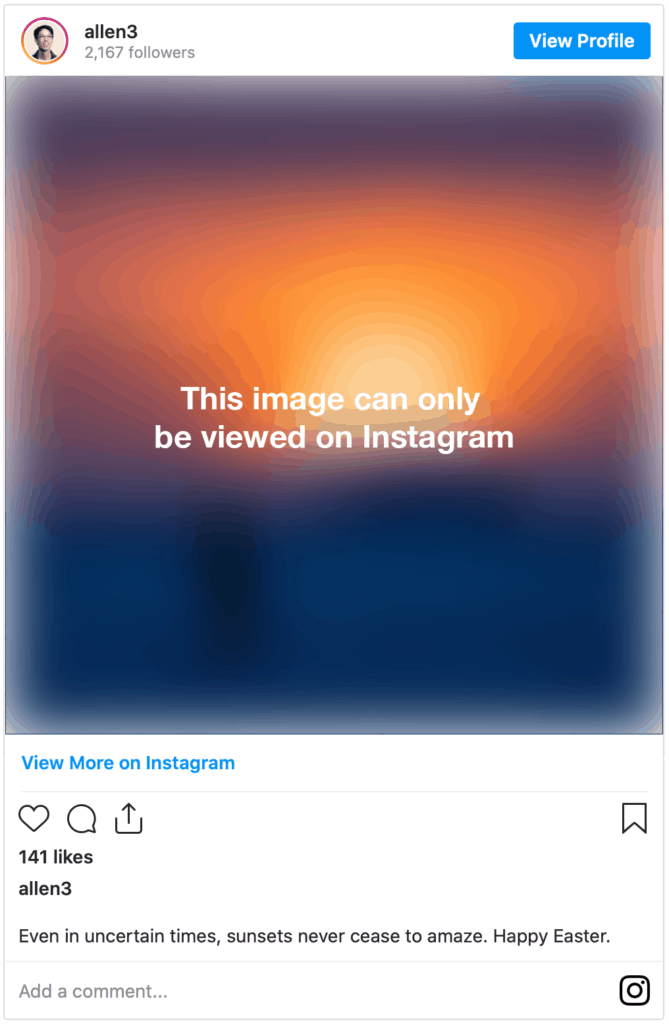
Instagram’s Moral Imperative
The past few years have made it abundantly clear that platforms hold disproportionate power in the online sphere – from Uber to Grubhub to Amazon. Online success is predicated on building both utility as well as a critical mass of users, and for that, platforms should be congratulated.
However, once we agree to the terms and conditions of the platform, we cede a tremendous amount of power and control while simultaneously becoming the product. And the balance of power is continually re-tipped in favor of the platform with opaque algorithmic changes, continuous monetization of user data, and in many cases, raw exploitation of constituents within the ecosystem.
For photographers, this phenomenon is no more obvious than on social media, where apps like Instagram have become so interconnected and influential that they almost have to participate to reach their arduously built audiences. Audiences that they don’t even own unlike, say, an e-mail list. Of course, photographers don’t have to join Instagram, but it’s a bit like running a business in the 1980s without a listing in the Yellow Pages.
As a part of Instagram’s Terms of Use, users grant the company:
a non-exclusive, royalty-free, transferable, sub-licensable, worldwide license to host, use, distribute, modify, run, copy, publicly perform or display, translate, and create derivative works of your content (consistent with your privacy and application settings). You can end this license anytime by deleting your content or account.
The language is typical of many photo sharing sites (including PhotoShelter), so in that sense it’s unremarkable. The company needs the ability to redisplay images, and wants to be able to have, for example, an image appear in the app, within an Instagram Story, and on the website without having to regain consent each time it comes up with a new feature.
But part of their feature set includes the ability to embed a post on other websites. As with YouTube, Twitter, TikTok and other social media platforms, embedding is a way to extend reach beyond the confines of the walled garden. And embedding has been a constant source of pain for professional creators.
On Monday, U.S. District Court Judge Kimba Wood ruled against photojournalist Stephanie Sinclair, who is well-known for her “Too Young to Wed” photo essay, which turned into a non-profit of the same name. Mashable offered Sinclair $50 to use her image within a 2016 story titled “10 female photojournalists with their lenses on social justice.” When Sinclair declined, they embedded an Instagram image, and Sinclair sued knowing that the case law of Goldman v. Breitbart was on her side.
It’s worth noting that Mashable is a content farm whose raison d’etre is to quickly generate and/or repackage content for the sole purpose of generating page inventory to sell ads. And if Sinclair’s image had no economic value to their story, then there would be no need to use it.
But this piece isn’t about Mashable. It is about Instagram. Instagram is a photo-driven platform, but it was never intended to primarily service professional photographers. Professional photographers have no claim to special treatment as much as they may claim that great photography drives the site. It arguably doesn’t. Celebrity and influencer content does.
This fact doesn’t mean that Instagram is powerless to help creators who want to protect their intellectual property. In fact, there is a simple fix that YouTube has had for years – namely, allow the user to decide whether content can be embedded or not.
The vast majority of users won’t care. They are driven by engagement (likes, comments, etc) and want to have their content reach as many people as possible through as many means as possible. But some content creators need or want to confine access to the app for the simple reason that they want to control who gets to use their content.
A simple fix would allow the user to check a preference to disallow embedding. When a post is embedded, Instagram could serve up a blurred image that could only be seen within the app. The photographer gets a link back to their Instagram presence without giving up their intellectual property without compensation.

Instagram and its parent Facebook have generated billions of dollars of wealth for their founders and employees. And they have every right to build their business any way they see fit. But consider the legal fees that Sinclair has accrued fighting Mashable, and consider an entire class of worker that will be adversely affected by Judge Wood’s ruling. The economic impact is non-trivial, and I would argue that the fix is so easy and would have so little impact on Instagram’s bottom line that they have a moral responsibility to act.
Yes, Sinclair opted in to Instagram’s Terms of Use, but the language was insufficient to prevent exploitation of her intellectual property. And I don’t believe that that was ever the intent of the Terms. Photographers should not have to fight this battle against the Mashables of the world when Instagram could solve the problem without batting an eyelash.

So where is the petition we could sign?
So Allen where do we write to add our voice to get your suggestions implemented?
Damed if we do damed if we don’t. Fighting corporate corruption and greed never is successful. Sad. If everyone joined in may be we would have a chance but it would take a miracle.
When the public-at-large concurs that piracy is stealing and NOT socially acceptable, FB and IG will have no choice but to end this occupational hazard. Honestly, as a serious photographer with over 40 years of extensive field experience, I don’t understand ANY photographer wanting to participate in the platform. Square format in a mobile phone app screams AMATEUR to me. I don’t take photos with my phone (Never will!!!) and I certainly will NEVER upload, edit, or post any photo from my phone. The fact that the app isn’t desktop-friendly tells me everything I need to know and more. NO Instagram for me–Not today, not tomorrow, NOT EVER!!! It’s fine for people wanting to post pics of their Denny’s Value Meal. Beyond that it’s always seemed useless and ridiculous. And Facebook’s just as bad, and probably worse. While I’ve been posting on FB for several years, I detest posting there for many reasons, because of their attitude regarding piracy–and rarely do these days. Sorry, but I don’t give a sh!t about Likes or “Nice pic” comments–that doesn’t pay my bills or support me in any way. I have come so close to deleting my account on numerous occasions. I believe it’s only a matter of time. Too many times, people just grab shots they like, post them, and they don’t even know where they stole them or from whom! On top of that, Zuckerberg lacks any sense of doing the right thing. I heard him state during a Congressional hearing that he has no intention implement any measures to deter inaccuracy or legitimacy of FB advertisers or their content. That’s as much as I ever need to know about Facebook (et al.), and Zuckerberg. I have another name for him!!! (Not printable here.)
I’m in. Where do we begin?
Why not leave a “copyright” or contact details over the centre of the image. I know it detracts from the image but a professional outfit or buyer will see through that and would no doubt contact the photographer. Another alternative would be to resize the image pre -upload to a resolution that would make copying pointless.
Neil,
I agree, just watermark all images with you name/business and contact info, if so desired. It may not stop it, but people will know who the image belongs to. A number of photographers do this.
And we have it even worse in Canada where there is little or no protection against the piracy of our images… hence the big © splashed across each and everyone of my images on Instagram …. and the few I put up on Facebook.
Great article though, if you do start a petition or other form of social awareness / education and need signatures, let me know and I’ll be happy to endorse your cause.
Let’s start the process and get a petition going. I don’t post on Instagram or Facebook cause it’s against you why should they make money from your intellectual content?
Judge Wood’s decision is clearly based on a single critical issue . Specifically that the plaintiff had given Instagram the right to sub-license images submitted by her to it. That right was set forth in writing in clear language – although in the middle of Instagram’s lengthy and intentionally confusing terms of use – and the judge cites specifically the very clear sentence permitting sub-licensing which is included in an otherwise confusing agreement. Don’t sign anything you don’t understand….ever.
Judge Wood therefore did not need to reach any other legal issue. The lesson is that if you don’t understand or don’t bother to read the terms of use/conditions etc don’t sign or agree to the terms. Courts do not exist for the purpose of relieving especially commercial parties, from the obligations or terms of a “bad deal” or agreement.
As attorneys litigating, lecturing and writing in this field on a daily basis, we have warned our clients, readers and seminar attendees that Instagram, Facebook and similar sites have what we consider to be unacceptable and dangerous terms and conditions for photographers.
The court’s decision is based on a simple “fact”. Ms. Sinclair did not want to issue a license directly to Mashable for the offered sum of 50$. So Mashable went to Instagram which (in effect) was given the right to sub-license to Mashable (or almost anybody else) without the photographer’s knowledge, consent or financial participation.